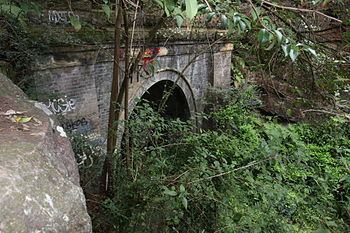Line Main Western Line Work begun April 1891 Closed 1913 | Location Glenbrook Opened December 1892 | |
 | ||
Length 31.5 chains (690 yd; 630 m) Owner New South Wales Government Railways | ||
Glenbrook tunnel
The Glenbrook Tunnel (1892) is a single-gauge railway tunnel, originally part of the 1892 single-track deviation, which bypassed the Lapstone Zig Zag across the Blue Mountains, New South Wales, Australia. It is approximately 660 meters (2,170 ft) long and is constructed in an 'S' shape with a gradient of 1:33.
Contents
The tunnel was built to the east of Glenbrook and opened on 18 December 1892. Due to the steep gradient, seepage keeping the rails wet causing slippage, poor ventilation and planned duplication of the track, plans were drawn up to bypass the steep route. Trains commonly stalled in the tunnel for some time before having to back the locomotive out of the tunnel for another attempt. The tunnel was closed on 25 September 1913, and was utilised for growing mushrooms. In 1942, during World War II, the Royal Australian Air Force (RAAF) stockpiled bulk mustard gas stocks in preparation for a possible Japanese chemical weapons attack. The facility was known as No. 2 Sub Depot of No. 1 Central Reserve RAAF and was vacated by the RAAF after the war. It features in the "Alcatraz Down Under" episode of Cities of the Underworld on the History Channel. Its past secret history has been revealed by Geoff Plunkett.
